May 2019 Newsletter
Welcome to the May 2019 issue of the Global Washington newsletter.
IN THIS ISSUE
- Letter from our Executive Director
- Issue Brief: Investing in Birth Attendants Reduces Maternal Mortality and Improves Overall Care
- Organization Profile: For PATH, innovative tools depend on supportive systems for success
- Goalmaker: Heidi Breeze-Harris, executive director of PRONTO International
- Welcome New Members
- GlobalWA Member Events
- Career Center
- GlobalWA Events
Letter from our Executive Director
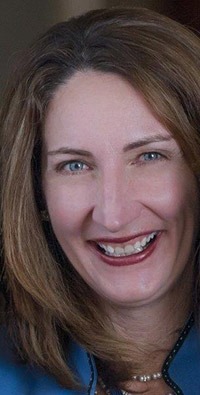
This past Sunday, I was reflecting on my incredible experience of being a mother. I have two wonderful kids who fill my heart with joy and my house with pop songs and stinky soccer cleats. However, giving birth to these kiddos was not so easy. In fact, one took 39 hours to be born, and with the other, I experienced post-partum hemorrhaging.
As hard as childbirth was, I also recognize my privileged circumstances living in Seattle as a white woman. I had both a doula and a midwife, and I gave birth in a hospital with extensive support. Such support is frequently absent for women in developing countries, and indeed also for many women of color in the U.S. And without quality care, the consequences can be dire. The World Health Organization estimates that 830 women globally die every day in childbirth or from preventable complications related to pregnancy. Every single day.
At Global Washington this month we are shining the spotlight on one aspect of childbirth that is often overlooked. A birth attendant is often the most critical person in preventing maternal and newborn death, and yet she is also often the least supported caregiver, and frequently faces the brunt of emotional or physical abuse. The contributions of birth attendants – the nurses, midwives and Aunties all over the world – are critical to achieving the Sustainable Development Goal of reducing maternal and newborn deaths globally.
Fortunately, there are organizations right here in Washington state helping to increase the number of skilled birth attendants and supporting their work. In this month’s newsletter you’ll learn about how PATH collaborates with clinical providers to develop tools and technologies that can make their jobs easier, and also makes sure they have systems in place to continue to improve the quality of care. In addition, we spotlight the amazing career journey of Heidi Breeze-Harris, co-founder of One By One, and the current executive director of PRONTO International.
Furthermore, I hope you can join me and our event partner, the Washington Global Health Alliance (WGHA), for an event on May 22 on the role of birth attendants in improving maternal and newborn health. We’ll hear from experts at PRONTO International, Health Alliance International, Worldwide Fistula Fund, and the Kati Collective.
This issue campaign was inspired by the upcoming Women Deliver conference in Vancouver, B.C., which will explore gender equality and the health, rights, and wellbeing of girls and women. We’ll continue to bring you context related to maternal health over the next several weeks. I hope you will join in the conversation.

Kristen Dailey
Executive Director
Issue Brief
Investing in Birth Attendants Reduces Maternal Mortality and Improves Overall Care
By Joanne Lu
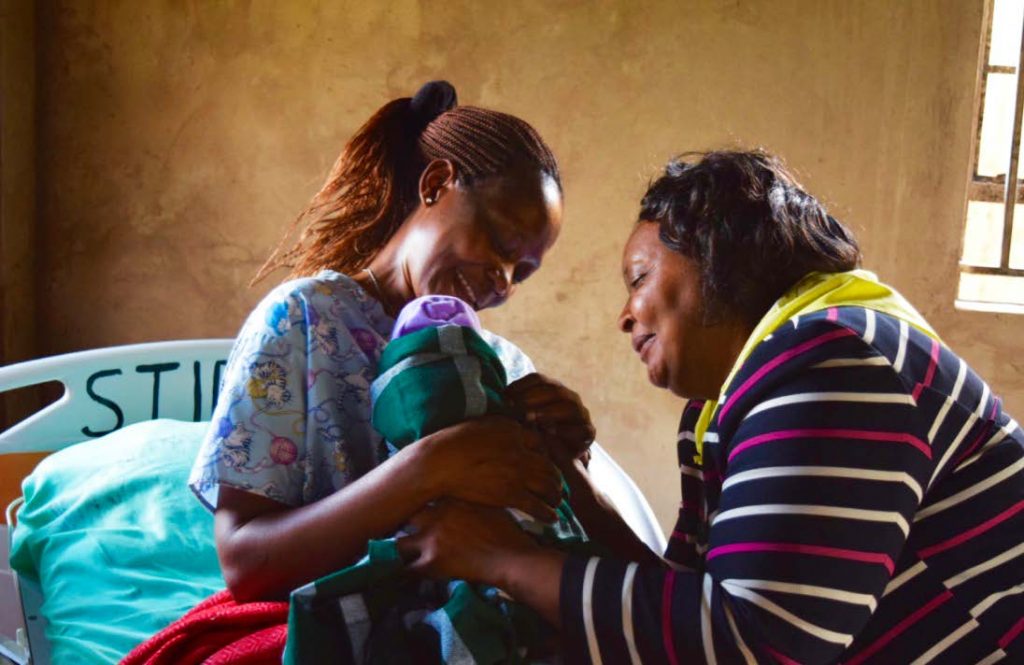
In this PRONTO simulation, Dr. Leah cares for a new mother and baby immediately following birth. Simulation is an important way for providers to practice patient-centered, respectful maternity care. Photo provided by PRONTO International.
Every woman deserves to give birth safely and with dignity. Yet sadly, maternal death during childbirth is not yet a thing of the past. Despite immense progress between 1990 and 2015 that nearly halved the global maternal mortality rate, the World Health Organization (WHO) estimates that about 830 women around the world still die every day from preventable causes related to pregnancy and childbirth. By 2030, the international community aims to reduce maternal mortality by 68 percent. But achieving that will require a concerted push to not only improve skilled delivery for mothers around the world but also build their trust through respectful care.
Safe birth environments require many functioning systems to work together. A single missing element can be dangerous, even fatal, for mothers and their babies. These elements include timely transportation, safe blood for transfusion, clean water and, perhaps most importantly, skilled birth attendants.
According to the UN Children’s Fund (UNICEF) and WHO, the presence of a skilled birth attendant – whether a medical doctor, nurse or midwife – can reduce the risk of death or stillbirth from delivery-related complications by about 20 percent. Yet only 78 percent of births in the world occur with assistance from a skilled birth attendant. In West and Central Africa, the coverage is a mere 56 percent. Without trained attendants who can recognize and respond to deadly complications such as hemorrhage or sepsis, about three-quarters of all maternal deaths occur during delivery and in the immediate postpartum period.
That’s why organizations like Maternity Foundation are developing training resources for skilled birth attendants in low- and middle-income countries. Over the last six years, Maternity Foundation, Copenhagen University and University of Southern Denmark have refined the “Safe Delivery App” as a training tool and job aid that is being used in over 40 countries. Primarily based on WHO guidelines, the app includes easy-to-understand clinical modules, essential practical procedures, action cards for emergencies and a comprehensive drug list. A randomized controlled trial in Ethiopia as well as case studies in other countries have shown that usage of the app has not only resulted in a marked increase in health workers’ skills and knowledge, but also in their confidence, especially in managing complications.
Training is one crucial aspect of improving maternal and neonatal care, but increasingly, the conversation is turning toward the well-being of the birth attendants themselves. According to Heidi Breeze-Harris, executive director of PRONTO International, birth attendants – particularly midwives and nurses, who are mostly women – are often the worst paid and worst treated of care providers.
When birth attendants are overworked, underpaid, traumatized by seeing too many deaths and treated horribly by doctors, patients’ families and others, they in turn take out their frustration on patients, says Sadaf Khan, a Senior Program Officer at PATH’s Maternal, Newborn, Child Health and Nutrition program. Sometimes it’s discrimination; other times constraints, slapping or abuse.
Recognizing this systemic problem, PRONTO and PATH work to elevate the status of care providers. PRONTO’s programs focus on the provider team as a whole and try to break down hierarchies that can interfere with quality care. Their training program gives birth attendants the chance to learn in lower risk environments, and simulations in which the provider plays the role of the mother help foster empathy. Other scenarios teach them not to lash out at patients and to ask for support when they need it.
Breeze-Harris recounts one birth simulation when the midwife called on a driver in the hall to help. It didn’t take long for the midwife to realize that she didn’t have to take care of 30 women on her own. Even if they weren’t technical hands, there were many ways to get hands there to help her.
“We help them find a way to manage what’s real for them,” Breeze-Harris says. “We meet them where they are, not where the algorithm says they should be.”
Famous for its innovative health technologies, PATH also works closely with providers to design and develop low-cost, effective, and easy-to-use devices according to the providers’ needs, wants and specifications. These include devices pre-filled with drugs that allow a single provider to administer the medication to multiple patients more quickly, or low-cost uterine balloon tamponades that help control hemorrhage.
But beyond just a safe and respectful delivery, global health experts are now promoting an even more holistic approach to maternal care. In 2016, the WHO released guidelines for a positive pregnancy experience to “ensure not only a healthy pregnancy for mother and baby, but also an effective transition to positive labor and childbirth and ultimately to a positive experience of motherhood.” The guidelines include recommendations on nutrition, malaria, HIV and even intimate partner violence.
Along those lines, PATH is working in communities through health education, preventative care, and a curriculum designed by mothers themselves to help women know their maternal rights and decide which procedures to undergo.
When women are empowered to speak up for themselves and providers are empowered to provide quality care, the outcomes can be dramatic. Positive experiences build trust, and word-of-mouth accounts can increase the number of women who seek care at facilities with skilled providers throughout their pregnancies – even their lifetimes. Of course, to achieve these outcomes, there must be continuous support with resources, training and accountability. But turning our focus to the wellbeing of mothers and those providing their care is the first step toward sustainable progress.
* * *
The following Global Washington members are working to improve maternal and newborn health through a variety of interventions.
Adara’s work in maternal, newborn and child health is primarily focused on strengthening services in central Uganda by supporting holistic program development, and undertaking high impact interventions and training. Adara does this to enhance health services and contribute to ending the preventable deaths of women, children, adolescents, and in particular, newborns. Adara partners with Kiwoko Hospital to help women deliver their babies safely, help newborn babies needing specialized care in the neonatal intensive care unit (NICU), provide community outreach services and health promotion, and train village health workers and clinicians from the local district health system. The Kiwoko Hospital NICU is considered a center of excellence in maternal and newborn health in East Africa.
Construction for Change believes maternal and child outcomes are inextricably tied to a community’s ability to access quality healthcare services. CfC seeks to increase access to healthcare by offering construction management expertise to organizations who need a new or improved building to increase their impact in the community. CfC’s healthcare initiative, the 30/30 Project, has specifically targeted maternal and child programs through the construction of four maternity wards and 18 rural health clinics around the world. These facilities have logged over 250,000 patient visits, including over 65,000 by children under 5 years old. The facilities also offer comprehensive prenatal care, with over 15,000 prenatal visits having taken place in the buildings over the past four years. Positive maternal and child outcomes have a reverberating effect throughout a community and access to a building where quality services can be obtained is central to CfC’s mission.
For 30+ years, HAI has worked to strengthen service delivery within, and expand access to, public sector MCH services. HAI considers the full system in which birth attendants operate and works to reduce barriers at each level. In Timor-Leste, HAI’s Liga Inan program has connected 47,000+ mothers nationwide to government midwives using mobile phone technology. Liga Inan empowers Timorese mothers to make informed decisions about their perinatal care in consultation with trained midwives. In Côte d’Ivoire, HAI has played a key role to integrate HIV, STI, and antenatal care services in 200+ health facilities, building birth attendant skills to provide specialized, comprehensive care to at-risk mothers and infants. In Mozambique, HAI is developing new ways for health providers and managers to use data to identify coverage gaps and implement localized, informed adaptations that respond to the specific needs of the families they serve.
In places where the needs are greatest — places of conflict and disaster — mothers and children are at even higher risk of disease and death. Medical Teams International provides prenatal check-ups, helps mothers give birth in clinics, and performs emergency C-sections to save the lives of mothers and babies. Once babies are born, the organization’s staff provide vaccines and treatments for pneumonia, malaria, and diarrhea. They also check for malnutrition and distribute supplemental food. Empowering women to keep their families healthy and safe is at the heart of what Medical Teams International does.
From Guatemala to Niger to Tajikistan, Mercy Corps has worked for years to combat child mortality through improving access to medical care and educational resources for new mothers. In Tajikistan, over 70% of the population lives in remote areas with limited access to medical care. In order to improve maternal and newborn health, Mercy Corps has trained over 1,200 local community members in over 600 communities to host community classes on pregnancy risks, childbirth and childhood nutrition. The classes have been attended by both new mothers and their mothers-in-law, as they hold significant influence over young women in most Tajikistan villages. Following the community trainings, mothers were 67% more likely to acknowledge danger signs during their pregnancy and visit their local health clinic. New mothers were also more likely to breastfeed exclusively, when prior to the trainings newborns and toddlers would have been given formula, sweet tea or biscuits crumbled in water.
Improving maternal, newborn, and child health is central to PATH’s mission and work around the world. PATH’s Maternal, Newborn, Child Health & Nutrition (MNCHN) program takes a health-systems oriented, multi-sector approach to strengthening the continuum of care for women, children, families, and communities. The MNCHN program provides core technical support and expertise to enable communities to survive and thrive by focusing on three broad, intersecting areas of work: strengthening maternal and newborn care; expanding nutrition policies, programs, and innovation; and integrating early childhood development into the broader MNCHN environment.
Planned Parenthood of the Great Northwest and the Hawaiian Islands
Since 2001, Planned Parenthood of the Great Northwest and the Hawaiian Islands (PPGNHI) Global Programs has worked to improve access to sexual and reproductive health education and services in low resource settings, including family planning. Family planning is integral to maternal health; access to contraception has been associated with reductions in maternal mortality and can improve maternal and child health outcomes by delaying or spacing pregnancies. Recently, the PPGNHI Global Programs team partnered with the Módulo Anexo Materno Infantil (MAMI) in the Dominican Republic to improve maternal and child health and sexual and reproductive health outcomes through a digital support network for adolescent mothers, supported by funding from Grand Challenges Canada (through the Government of Canada). Through WhatsApp groups, they share educational messages and provide a forum with the aim of increased use of post-partum family planning, increased attendance at well-child and vaccination appointments, and increased social support measures.
The name “PRONTO” evokes a necessary urgency – birth attendants typically have fewer than five minutes to diagnose and deliver solutions to life-threatening emergencies affecting mothers and babies during childbirth. PRONTO International conducts simulation-based training designed for healthcare provider teams in limited-resource settings. PRONTO’s mission is to provide locally-owned, sustainable training that improves the capacity of frontline providers to save the lives of mothers and babies. More than 5,000 providers have been trained in ten countries, including nurses, traditional midwives, doctors and other providers who care for women and infants during labor and delivery. In addition, there are now more than 150 PRONTO trainers and PRONTO master trainers in Mexico, Guatemala, Kenya, Uganda, India, and the United States.
Working in 157 programmatic countries, UNICEF supports governments and communities in scaling up maternal, newborn, and child healthcare services. UNICEF provides vaccines to roughly 45% of the world’s children, and works with community healthcare workers to promote breastfeeding. In 2017, over 25 million live births were delivered in facilities supported by UNICEF, and $665 million was invested in nutrition programs, helping treat 4 million children for severe acute malnutrition in 67 countries. Since 2011, UNICEF and partners have helped eliminate maternal and neonatal tetanus from an additional 26 countries through the Eliminate Project, averting an estimated 24,000 newborn deaths annually.
World Vision’s maternal, newborn and child health (MNCH) programs work predominantly in the communities hardest hit by injustices, recognizing that the health of mothers and children cannot be separated, and that providing newborns with optimal nutrition and access to essential care promotes a basic human right. World Vision establishes community health committees, mother support groups, and “peer mothers” who help with breastfeeding and early infant nutrition. Through World Vision’s interventions, more than 220,000 community health workers have been trained and are now equipped to focus on prevention, providing key messages at the household level as well as essential care to new mothers and infants.
Worldwide Fistula Fund protects and restores the health and dignity of the world’s most vulnerable women by preventing and treating devastating childbirth injuries. The organization seeks to improve global women’s reproductive health and the safety of childbirth by improving the capacity of low-resource countries to meet women’s health care needs. WFF works to identify women who need fistula treatment and then provides life-changing surgeries, performed by expert fistula surgeons. Recovery and support includes post-op care, safe places to heal, meals, and integrated physical therapy. WFF supports advocacy and support groups through counseling and connecting survivors to local mentoring groups. Women are encouraged to participate in education and vocational skills training in literacy and health. WFF also funds training for community members in fistula awareness. In Ethiopia, WFF offers an enhanced OB-GYN residency training program and a specialized Urogynecology Fellowship training program.
Organization Profile
For PATH, innovative tools depend on supportive systems for success
By Joanne Lu
Since its founding in 1977, PATH has become a giant in global health technology. With 1,600 employees working in 70 countries, PATH estimates that its innovations touch the lives of more than 150 million people each year. PATH works with a range of stakeholders and partners including, but not limited to, industry, governments, research institutions, and academia to address some of the world’s most pressing health problems, including those affecting mothers and newborns
About six years ago, the organization began to reevaluate how its work can transform entire systems. Instead of focusing strictly on technologies for individual projects, PATH has adopted a multidisciplinary “platform-based approach” that brings together the expertise of its teams across multiple countries and disciplines in order to research, design, scale up, and advocate for systemic innovations that make prevention and treatment more affordable, accessible and effective.
“Technologies are a very powerful piece of the armamentarium, but they’re just one piece,” says Sadaf Khan, a senior program officer with PATH’s Maternal, Newborn, Child Health & Nutrition Program.
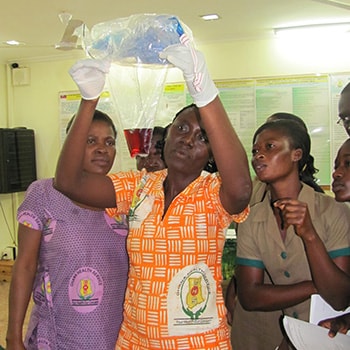
Health workers in Ghana learn to use the blood collection drape to measure post-partum blood loss. Photo: PATH/Patience Cofie.
Khan, a physician originally from Pakistan, has spent the last eight years at PATH, primarily working on maternal health, but also on areas that intersect with her expertise, such as drug and device development and maternal immunization. She also looks at the potential of antenatal and postpartum care as platforms that can introduce women to a whole range of other health services for the rest of their and their children’s lives. These include nutrition, immunization, family planning and sexually transmitted infections, and malaria prevention and control.
“Everything PATH does in some way touches upon the lives of women and children,” Khan says.
And yet, Khan says they have found that their technology innovations achieve their transformative potential only when providers and patients in low- and middle-income country settings receive systems support they need.
“You can have these wonderful technologies, but if you have providers who are not trained in their use, or who are unsure of their ability to use them, there’s only so much good a tool can do by itself. Systems need to be built around the people who are providing those services, and they need to address the needs of the people – the women – who are receiving those services.”
Part of the solution is making sure that providers are being trained in up-to-date best practices and guidelines and that there’s a structure within which they can bring up issues that arise. But tools also need to be developed with the providers’ needs in mind.
For example, Khan notes that according to the World Health Organization, 99 percent of maternal deaths occur in low-resource settings, primarily in South Asia and sub-Saharan Africa. One of the most common causes of maternal death is postpartum hemorrhage. Severe postpartum hemorrhage can kill a mother in less than two hours. Oxytocin is the recommended drug of choice for preventing and treating it. Yet, according to Khan, it’s an underutilized intervention.
So, PATH asked, what are the barriers to the use of oxytocin for postpartum hemorrhage prevention? And how can it be used more widely? This issue was approached from a technology and systems lens. PATH’s technology solution was a simplified pre-filled device. That way, when there is only one birth attendant for several patients – as is often the case in low-resource settings – the birth attendant can administer it quickly. Additionally, the device is so simple that even health workers with fairly low levels of expertise can learn to use it quickly and easily.
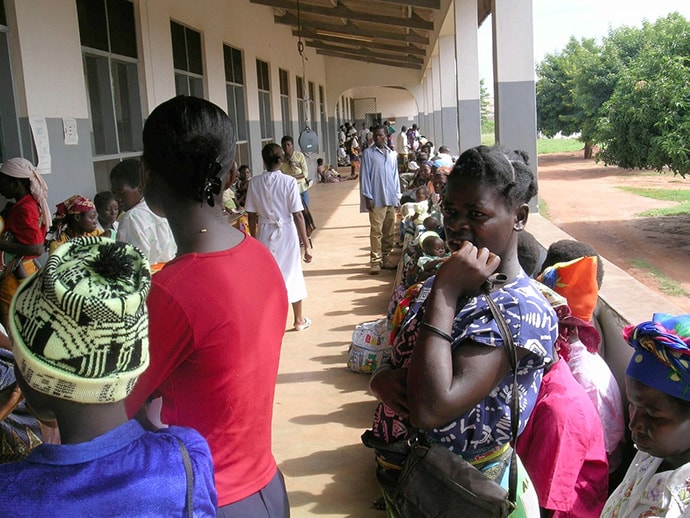
Women in Uganda wait for their turn to see a provider at a health facility. Photo: PATH MediaBank
Second, PATH asked, what is the quality of the drug? Khan says they found in PATH’s work in Ghana and India, even when women were receiving oxytocin, the drug, especially when procured from private pharmacies, had very low levels of the active ingredient. Building an evidence base around quality and storage conditions has been key to addressing a systemic problem. This has included advocacy around procurement of quality oxytocin, as well as potential systems solutions, including exploring the integration of oxytocin into alternate cold chains, such as those for vaccines.
Third, PATH looked at the current practices, both from the provider perspective and from the community perspective. She says that while oxytocin may be underused for prevention, there’s often significant misuse to induce and augment labor, as providers respond to the demands of the patient’s family in certain settings. To address this challenge, PATH focused on training providers to optimize the drug’s appropriate use and to prevent misuse, as well as developing communication messages intended for families to minimize the misuse of the drug.
Armed with a bundle of evidence, PATH then approached policy makers in specific geographies to provide support and information for the development of a postpartum hemorrhage policy that addresses issues along the prevention-management continuum and looks at all the issues around providers’ skills, the availability of tools, and community demands. Working collaboratively with the policy makers, PATH aims to ensure that not only are changes made where needed but that all information is available to all providers.
PATH works closely with providers in developing tools that can improve care. For example, in cases where hemorrhaging is not managed by first line treatments, traditionally manual pressure is applied to stop the bleeding. But again, given workflows and patient load, manual pressure is not always a viable option.
For bleeding that is non-responsive to initial treatments or where these may be unavailable, the use of uterine balloon tamponades (UBT) can prove lifesaving, reducing blood loss and the need for risky and costly surgical interventions and blood transfusions. The UBTs available to providers in a developed country setting are effective but often too expensive for low resource settings. In these settings, it was observed that providers were rigging up their own UBTs with available items, such as catheters, condoms, and syringes. While certainly an ingenious solution, these approaches take time to assemble.

A prototype of the Sinapi uterine balloon tamponade (UBT) inflated with water. Photo credit: PATH/Patrick McKern.
Taking these needs into consideration, PATH has worked with providers, developers and researchers to develop an inexpensive all-in-one, pre-assembled UBT with all the design features that the providers themselves wanted. It’s a fully assembled system that can begin working in less than one minute, and the estimated cost is a fraction of the cost of UBTs used in the U.S. PATH estimates that an affordable UBT could save up to 6,500 lives annually and avert almost 11,000 surgeries just in sub-Saharan Africa alone. The Innovation Countdown 2030 report estimates that widespread use of the UBT could save the lives of 169,000 women by 2030.
Empowering providers with the appropriate tools, trainings and support makes a monumental difference in the care that is delivered. As one provider told Khan, “It’s very frustrating to me to not know whether the skill set that I have is even up-to-date. Now I feel full confidence in my ability to deliver these services. I feel empowered, and I feel my attitude and my interactions with my patients have improved and changed for the better.” The quality of care from a confident and well-equipped provider also shapes women’s perceptions of care. It can affect whether a woman will continue to seek care for herself, as well as how and when she will take her children to a health care provider and whether she will encourage others in her community to do the same.
That’s why Khan says PATH is focused on moving forward with not just providers’ needs in mind, but with a women-centric approach.
“Much of the new global guidance coming out is recognizing that we need to move beyond thinking only vis-a-vis health outcomes – which are undoubtedly critical – to the experience of pregnancy and childbirth as a positive experience that is empowering for women.”
Through its work with communities, PATH is integrating ways to keep women informed as partners in the process of tackling maternal mortality.
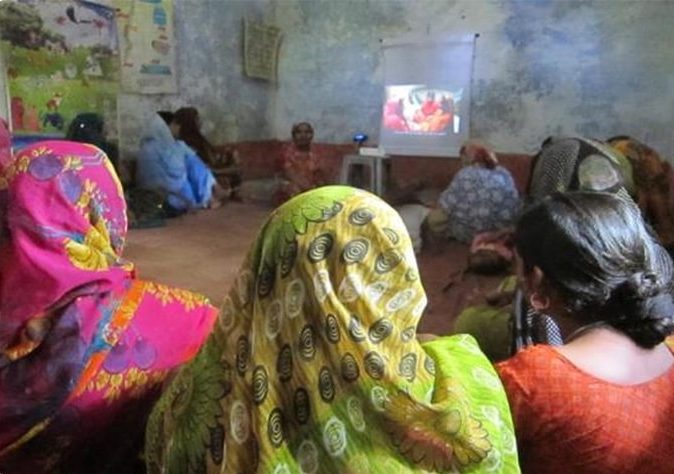
A community-led behavior change strategy in India uses digital video technology.
Photo: PATH/Kiersten Israel-Ballard.
“There is an understanding that even if a woman receives services that are technically sound but she leaves with an overall negative experience of her childbirth experience due to lack of other dimensions of quality, we as providers have failed that woman,” says Khan. “For me, addressing these is the next step to accelerating progress.”
Goalmaker
Heidi Breeze-Harris, executive director of PRONTO International
By Angelia Miranda
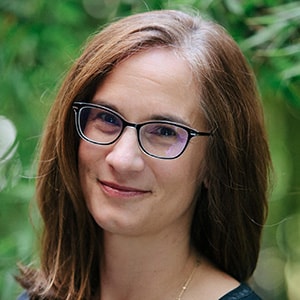 For Heidi Breeze-Harris, working in the global health sector may not have been an obvious path, but in retrospect, it makes sense. Thanks to the trips that she and her mother saved up for every summer, and growing up with a diverse extended family, Breeze-Harris has always had a strong connection to the international sector. “Because I started traveling to pretty out of the way places when I was young, I was comfortable in those settings,” she says.
For Heidi Breeze-Harris, working in the global health sector may not have been an obvious path, but in retrospect, it makes sense. Thanks to the trips that she and her mother saved up for every summer, and growing up with a diverse extended family, Breeze-Harris has always had a strong connection to the international sector. “Because I started traveling to pretty out of the way places when I was young, I was comfortable in those settings,” she says.
But what she saw within those settings didn’t always make sense.
One of the greatest influences in her life, her grandfather, instilled in her a lesson as a child. “He taught me that there is nobody lesser than me, and nobody better. We are all the same level of human.” Breeze-Harris internalized his words, but the inequality and injustice she saw during her travels made her wonder how they could be true when reality looked so different.
“My grandfather instilled this belief and then I went into the world.” As a 5-year-old child in Lima, she recalls asking herself, “How do I get to eat breakfast and these other children my age don’t. Why can’t they have what I have? And is it wrong that I do?”
Upon finishing college with a degree in anthropology and Asian studies, Breeze-Harris considered looking for international work. “I also loved, and love art and I thought what better time to experiment with work in the arts than when I am young and have little to lose.” A conceptual artist, she has embraced music, acting, sculpting, photography, and painting. In fact, her first job was with local glass sculptor and artist, Dale Chihuly. “I started as a receptionist with Dale and worked my way up,” she says.
With long hours and dedication, within six months Breeze-Harris became Chihuly’s book designer and museum liaison, and she worked with the installation design teams in the studio. After six years, she shifted her focus from art to urban design in service to community development.
After working as an urban designer for low-income communities, Breeze-Harris received a fellowship in 2003 to work with immigrant communities in Kobe, Japan, who had been displaced and disenfranchised after the Hanshin Awaji earthquake. It was after returning from Japan that she first heard about the medical condition, fistula.
Obstetric fistula is a childbirth injury caused most often by women experiencing obstructed labor without access to timely medical care. In obstructed labor the baby’s head puts pressure on the mother’s birth canal, which if left unrelieved can result in a stillborn baby and the mother with a hole in her bladder or rectum. An estimated 2 million women worldwide suffer from fistula. Because women with fistula can leak urine and and/or feces chronically, they often face ostracism, isolation, shame, and a heightened risk of death.
Breeze-Harris was herself one month pregnant when she began learning about fistula. It went from being a topic completely unknown to her to suddenly showing up in her life three times in one week. “I think that’s a sign that something’s worth paying attention to,” she said. And so she did.
Together with her friend, Katya Matanovic, she co-founded the organization, One By One, to work with women in East Africa and implement a holistic approach to fistula treatment and prevention. She learned more about fistula and its impact on girls and women in low-income countries. In an ironic twist, her own pregnancy took a turn for the worse, and Breeze-Harris almost died from obstructed labor.
“Because I lived in the U.S.,” she explained, “I was able to have a cesarean section in time.” Once again, the questions raised by her grandfather’s lessons seemed to apply; only this time the difference between her and others like her was access to life-saving resources.
Breeze-Harris never intended to start an organization like One By One. As a new mother, she fully expected to hand the project off to the UN Foundation. “I had my own child,” she points out. But the UN Foundation gave One By One a startup grant and encouraged them to keep going.
After 11 years, she left One By One, in need of a chance to recharge. But the work she started continued on. In 2018, she watched with pride as One By One merged with the Worldwide Fistula Fund, a Global Washington member. “I am so thrilled the work continues. That’s what’s happening, and it is happening in an even bigger and better way than either organization would have been able to do alone.”
On the flipside, the team One By One helped to build in Kenya now operates and functions as its own NGO. “The leadership is theirs,” she affirmed. Looking back at all that One By One has accomplished since she left, she says, “To say I’m proud is a weird way to put it—I’m humbled that I was able to connect and work alongside incredible leaders who made all of this happen. This work is led by fistula survivors there. That is how it should be.”

Heidi Breeze-Harris (center) in Migori County, Kenya, with midwives who have just undergone a week of PRONTO training and are receiving their certificates of completion. Photo provided by PRONTO International.
Breeze-Harris continues her work in global and maternal health as the current executive director of PRONTO International, an organization that provides innovative low-cost obstetric training to clinical providers in resource-limited settings around the world.
The philosophy that PRONTO International embodies is the idea that clinicians are not separate from mothers and babies—rather, they are an essential part of the childbirth process and the “mother-baby-provider” triad. As such, the organization focuses on offering clinical providers the emotional, psychological, and technical support they need not only for the safety of mothers and children, but also for their own well-being, because confident providers save lives.
When asked about her confidence in the global community’s ability to accomplish the Sustainable Development Goals relating to global health by 2030, she expressed a general sense of optimism. At the same time, she cautioned that the global community must not forget all those encompassed by the term “global.” For instance, the United States is the only developed nation where rates of maternal death are increasing, especially in populations of women of color.
“It is important that we highlight the relationship between our healthcare system, racism and pregnancy outcomes,” she said.
While PRONTO International works in low-resource areas across the globe, it also sells birth simulation kits to American providers and universities. PRONTOPacks™ allow clinicians in any setting to simulate birth in a highly realistic and innovative, yet sustainable, low-tech and low-cost manner.
In pursuing innovative ways to train birth attendants, from offering PRONTOPacks™ to developing curriculum and training plans in collaboration with local governments, PRONTO International aims to develop practitioner skills in-country, while ultimately placing the responsibility of continuing the programs with the countries themselves. “Our goal has to be to make it sustainable within country budgets and staffing systems.”
Tracing a path from the office of an artist to the forefront of innovative organizations in global health and maternal care was certainly never the plan. But if there is one thing Breeze-Harris illustrates, it is following her passion wherever it may lead.
Today, Heidi Breeze-Harris brings her creativity to the role of changing the very inequality and injustice that she witnessed in the world as a child. By ensuring that future mothers can get what they need, regardless of where or who they are, she helps to make her grandfather’s words a reality: nobody less, and nobody better.
Welcome New Members
Please welcome our newest Global Washington members. Take a moment to familiarize yourself with their work and consider opportunities for support and collaboration!
One Equal Heart Foundation
One Equal Heart is a Seattle-based nonprofit that collaborates with indigenous leaders to honor and nurture sustainable agriculture, equitable communities and traditional knowledge. oneequalheart.org
SG Foundation
SG Foundation trustees and staff collectively strive to serve God and the poor by relieving suffering and improving the quality of life in communities and for the individuals in those communities both locally and around the world. sgfoundation.org
YWCA SEATTLE | KING | SNOHOMISH
YWCA is on a mission to eliminate racism and empower women. ywcaworks.org
Member Events
April 2-June 4: UW Henry M. Jackson School of International Studies // Spring 2019 – Trump in the World, Lecture Series
May 18: Rwanda Girls Initiative // 5K Run
May 18: Construction for Change // Annual Benefit
May 20-21: Washington Nonprofits // Washington State Nonprofit Conference
May 31: UW Evans School of Public Policy // xTech + Impact 2019 Summit
Career Center
Director of Machine Learning, Vulcan Inc
Operations Officer, Schools for Salone
Chief Financial Officer, Landesa
Check out the GlobalWA Job Board for the latest openings.
GlobalWA Events
May 22: Mother, Baby, Provider: Completing the Triangle
May 30: Changing the World Without Losing Your Mind – Book Tour by Alex Counts
June 6: Illegal Wildlife Trafficking: Local Efforts on a Global Threat
June 7: Disability Inclusive Development Initiative Workshop
June 20: Final Mile Disaster Response: Amazon’s Community Engagement